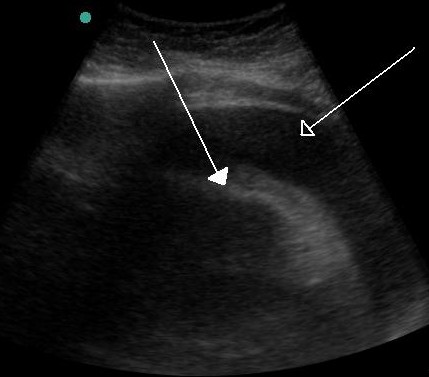Pericardial effusion echocardiography
|
Pericardial effusion Microchapters |
|
Diagnosis |
|---|
|
Treatment |
|
Case Studies |
|
Pericardial effusion echocardiography On the Web |
|
American Roentgen Ray Society Images of Pericardial effusion echocardiography |
|
Risk calculators and risk factors for Pericardial effusion echocardiography |
Editor-In-Chief: C. Michael Gibson, M.S., M.D. [1]; Associate Editor(s)-in-Chief: Abdelrahman Ibrahim Abushouk, MD[2]
Overview
The role of echocardiography is to chracterize the presence, size, location, and hemodynamic impact of a pericardial effusion. Echocardiography is not needed to diagnose the cause of pericardial effusion. The finding usually include presence of moderate and large pericardial effusion, swinging of the heart within the effusion and reversal of right atrial and right ventricular diastolic transmural pressures. Echocardiography should be performed if there is a suspicion of tamponade (e.g. distended neck veins, pulsus paradoxus).
Echocardiography
- The American College of Cardiology (ACC), the American Heart Association (AHA), and the American Society of Echocardiography in its recommendations on echocardiography gave strong recommendations for echocardiography in pericardial disease.[1]
- Two dimensional and doppler echocardiography should be done in all suspected cases of cardiac tamponade and pericardial effusion.
- Follow up/sequential echocardiography for assessment of impending cardiac tamponade should be considered.
- Helps in diagnosing pericardial disease, hemodynamic parameters (pressure in different cardiac chambers).
- Pericardial effusion secondary to pericarditis is seen on echocardiogram as a large hypoechoic region surrounding the heart.
- The best view to visualize a pericardial effusion is the subcostal view.
- The location of the fluid and the presence of loculations can be determined so that the feasibility and safety of pericardiocentesis can be assessed. Usually pericardiocentesis can be performed if there is over 0.5 cm of anterior fluid.
Findings
- Presence of moderate and large pericardial effusion.
- Swinging of the heart within the effusion. It is this swinging motion that gives rise to electrical alternans.
- Reversal of right atrial and right ventricular diastolic transmural pressures.
- Cardiac chamber indentation or collapse is a common finding in cardiac tamponade.
- Right atrium and right ventricle are the commonest to collapse when intrapericardial pressure exceeds intracardiac pressure within any particular chamber.
- Right atrial collapse:
- Right atrial pressure is minimal during diastole. However, pericardial pressure is maximal in diastole. Due to this the first signs of collapse could be seen during right atrial diastole.
- Right atrial collapse if persists for > 1/3rd of cardiac cycle is a good indicator of impending tamponade.
- Transient right atrial collapse can occur normally also.
- Diastolic collapse of right ventricle is very specific for cardiac tamponade.
- Diastolic left atrial collapse are very specific for cardiac tamponade.
- Left ventricle collapse is uncommon due to high thickness of ventricular wall.
- The respiratory variation of mitral valve and tricuspid valve is increased.
Pericardial Effusion and Cardiac Tamponade
In pericardial effusion, large hypoechoic regions are seen surrounding the heart with presence of oscillatory motion of the heart.
The echocardiogram below demonstrates swinging motion of the heart in cardiac tamponade.
{{#ev:youtube|U4xQ3-VRiNg}}
Echocardiography of heart with loculated pericardial effusion compressing the left ventricle {{#ev:youtube|unnmmlCyyZM}}
Cardiac tamponade {{#ev:youtube|YWVI6rRTIzU}}
Cardiac tamponade {{#ev:youtube|_az8_V6bHE8}}
Left ventricular free wall rupture in patient with cardiac tamponade {{#ev:youtube|g9TdKcFRiLo}}
Collapse of right ventricle in patient with cardiac tamponade {{#ev:youtube|dwJkJr00v5c}}

References
- ↑ Cheitlin MD, Armstrong WF, Aurigemma GP, Beller GA, Bierman FZ, Davis JL, Douglas PS, Faxon DP, Gillam LD, Kimball TR, Kussmaul WG, Pearlman AS, Philbrick JT, Rakowski H, Thys DM, Antman EM, Smith SC, Alpert JS, Gregoratos G, Anderson JL, Hiratzka LF, Hunt SA, Fuster V, Jacobs AK, Gibbons RJ, Russell RO (2003). "ACC/AHA/ASE 2003 guideline update for the clinical application of echocardiography: summary article: a report of the American College of Cardiology/American Heart Association Task Force on Practice Guidelines (ACC/AHA/ASE Committee to Update the 1997 Guidelines for the Clinical Application of Echocardiography)". Circulation. 108 (9): 1146–62. doi:10.1161/01.CIR.0000073597.57414.A9. PMID 12952829. Retrieved 2012-09-14. Unknown parameter
|month=ignored (help)